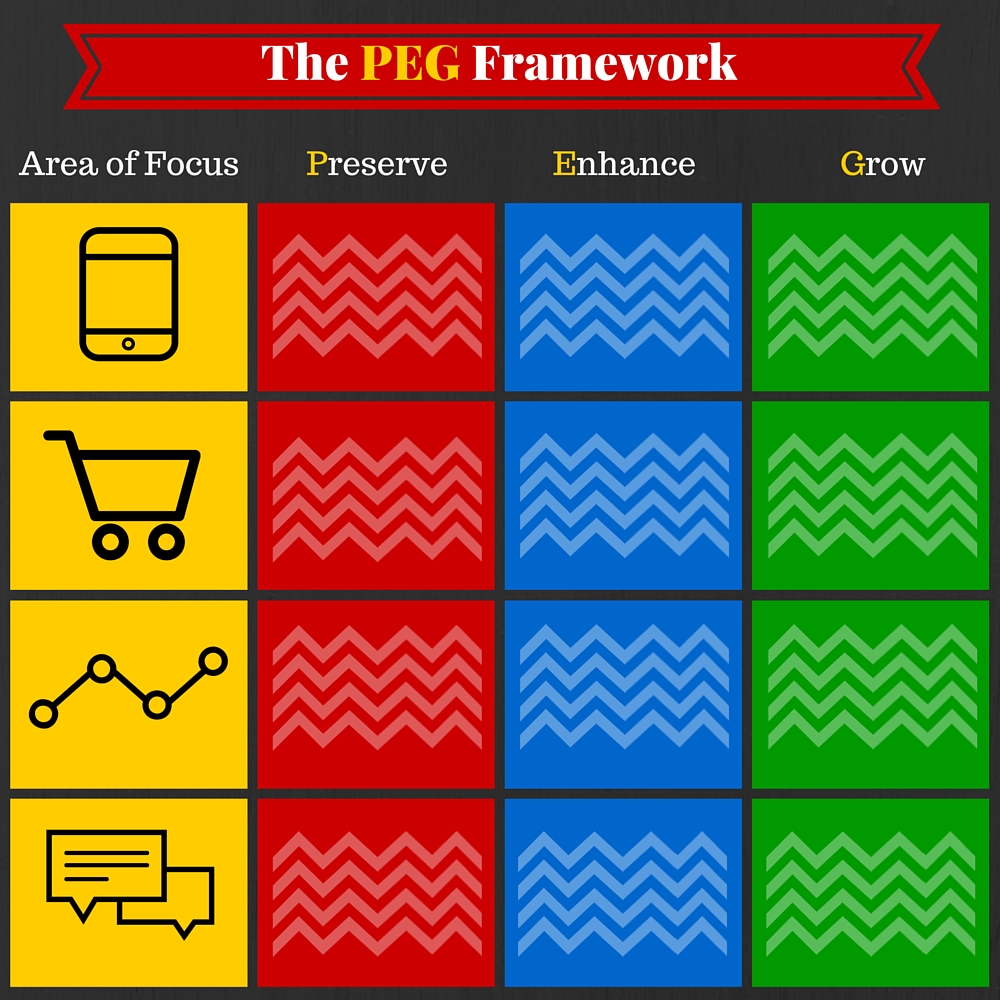Learn 3 Core Elements to Run a Successful & Sustainable Business
Running a successful online business is getting more difficult every day. And once you’ve achieved a certain level of success, it gets even more difficult to sustain that success and continue growing it. That’s why I created The PEG Framework – a mental model for running a successful and sustainable business.
With any business, there are many distractions you will face every day. The bigger you get, the more distractions there seem to be. The PEG Frameworkhelps any business, department, or person reduce these distractions by focusing on three core areas that make up the acronym PEG: Preserve or maintain, Enhance, and Grow or expand. You can also apply this to certain areas of focus within your business. For example:

1. Preserve or Maintain
Every business has a core product, service or some other cornerstone that defines its existence. If you’re not sure what this is, then you have bigger things to worry about!
The core tenet here is maintaining the things that are currently working wellfor your business. If it’s a small business or startup, this could be a few core elements. If it’s an enterprise, then each department may have its own areas of focus derived from the company goals.
In essence, don’t break pieces that drive the most business value. And ensure you have processes in place to identify when something does break, then fix those breakpoints as quickly as possible.
There is typically lots of nitty gritty work involved here. And much like an automobile, without a steady dose of maintenance your money-making machine will eventually break down and have more serious and costly issues.
What areas should you preserve?
Specific areas of maintenance will obviously depend on your business. Start by focusing on the driving forces behind your key performance indicators (KPIs). If you’re not sure what those KPIs are, then you start by following the money, working backwards, and identifying what those KPIs and drivers are.
Larger businesses and enterprises will likely have departments with varying KPIs specific to those teams, but the same principles of maintenance and preservation apply. For example, if you have a marketing initiative that is working well and generating a great ROI, then you should actively maintain that initiative.
2. Enhance Existing Products & Services
If everything is working well and the core business is healthy, then you shouldfind ways to enhance existing efforts, products, services, etc. For example, you may want to find new ways to increase efficiency, return on investment, user experience, conversion or other drivers of the business.
The core tenet here is to continue finding ways to improve the parts of your business that are performing well and the parts that aren’t. If you’re an enterprise with lots of teams and departments, this is especially true becauseas a company grows, it becomes more challenging to maintain certain levels of efficiency and quality.
If each team or department is focused on ways they can enhance the business, then you should see incremental wins over time that add up to significant gains. This part of the framework is where you should see things like more conversions, happier customers and increased profit over time.
3. Grow & Expand
The final part of the framework is an area that should only be focused on once the core business is healthy and you are generating (or know for a fact you can generate) a profit. This is when you should consider investing in ways to expand and grow your core business.
This part of the framework is where you may decide to diversify and grow your existing products or services. Or, if it makes sense, you may decide to expand beyond your core. Though typically it’s wiser to kickstart growth by expanding into natural extensions of your business. For example, if you currently sell pillows you may decide to expand by selling pillow covers or blankets.
For large and enterprise-sized business, certain departments may naturally be more focused on growth than others, but that doesn’t mean these teams can’t find ways to expand and grow their areas of responsibility or even affect other areas.
Diversify, Diversify, Diversify!
As a business grows, it’s also wise to diversify sources of traffic and revenue. This is especially true online. You don’t want to put all your eggs in the Google basket, the Facebook basket, or any other basket that you don’t own. Diversify, diversify, diversify. Then grow and refine those channels so if you lose one, you still have a healthy and sustainable business.
If your business is too reliant on one source and that source has all the power, they could make a change and potentially kill your margins, profits, or even worse your business.
It’s also important to have a disciplined approach to growth and expansion. Your business must be healthy and efficient enough to sustain that growth. Admittedly a good problem to have, but growing too fast can sometimes destroy a business if there are too many inefficiencies to support that growth. You don’t want to make existing problems worse. It would be like expanding your garden or house but not having the proper irrigation system or foundation to support it.
Conclusion
The PEG Framework may seem rather open-ended and simple, but that’s what makes it so great. You can apply this to a whole business, to a department, to personal goals and more. As with most things, success or failure ultimately comes down to execution.
In my next article, I’ll show you how you can use this framework in conjunction with an OKR framework to deliver great results for your business and team.
Things to Think About
- What are some ways you can use this framework to improve your business?
- Is there anything you would do differently?
- Is this something your teams can use to help the business achieve its goals?
Want to put this framework to work for you?
Contact me for a free consultation.
This article was originally published at valentinesiefermann.com.






